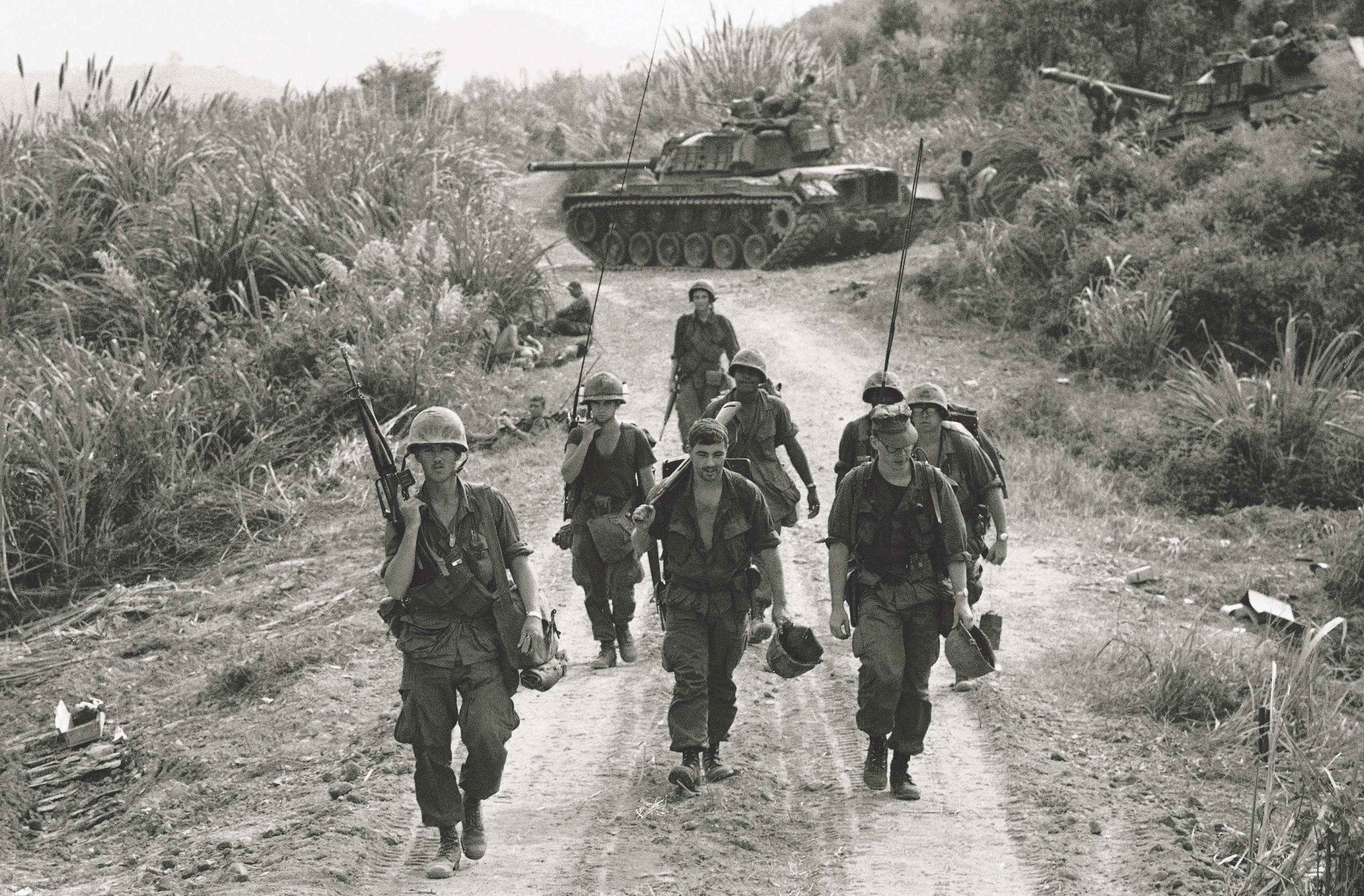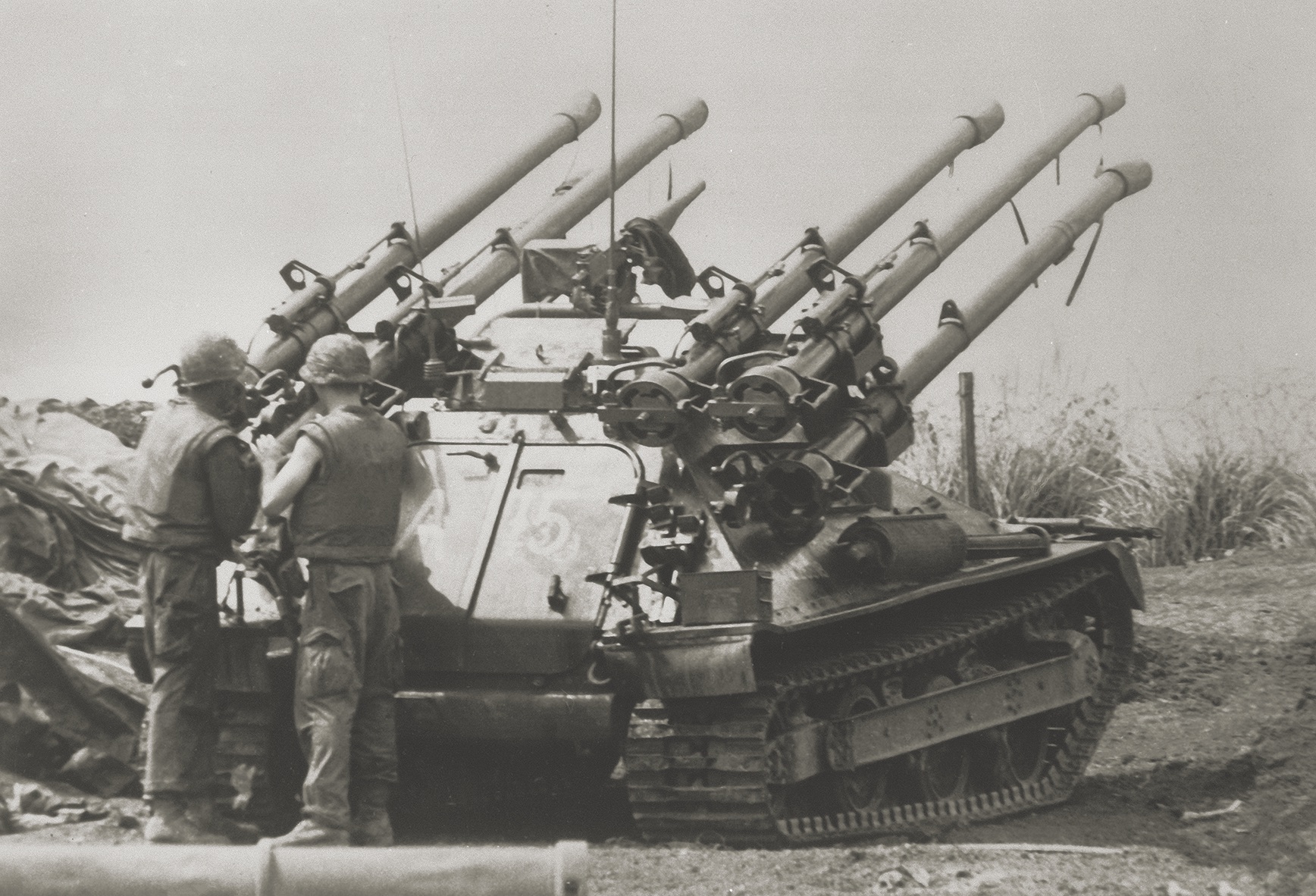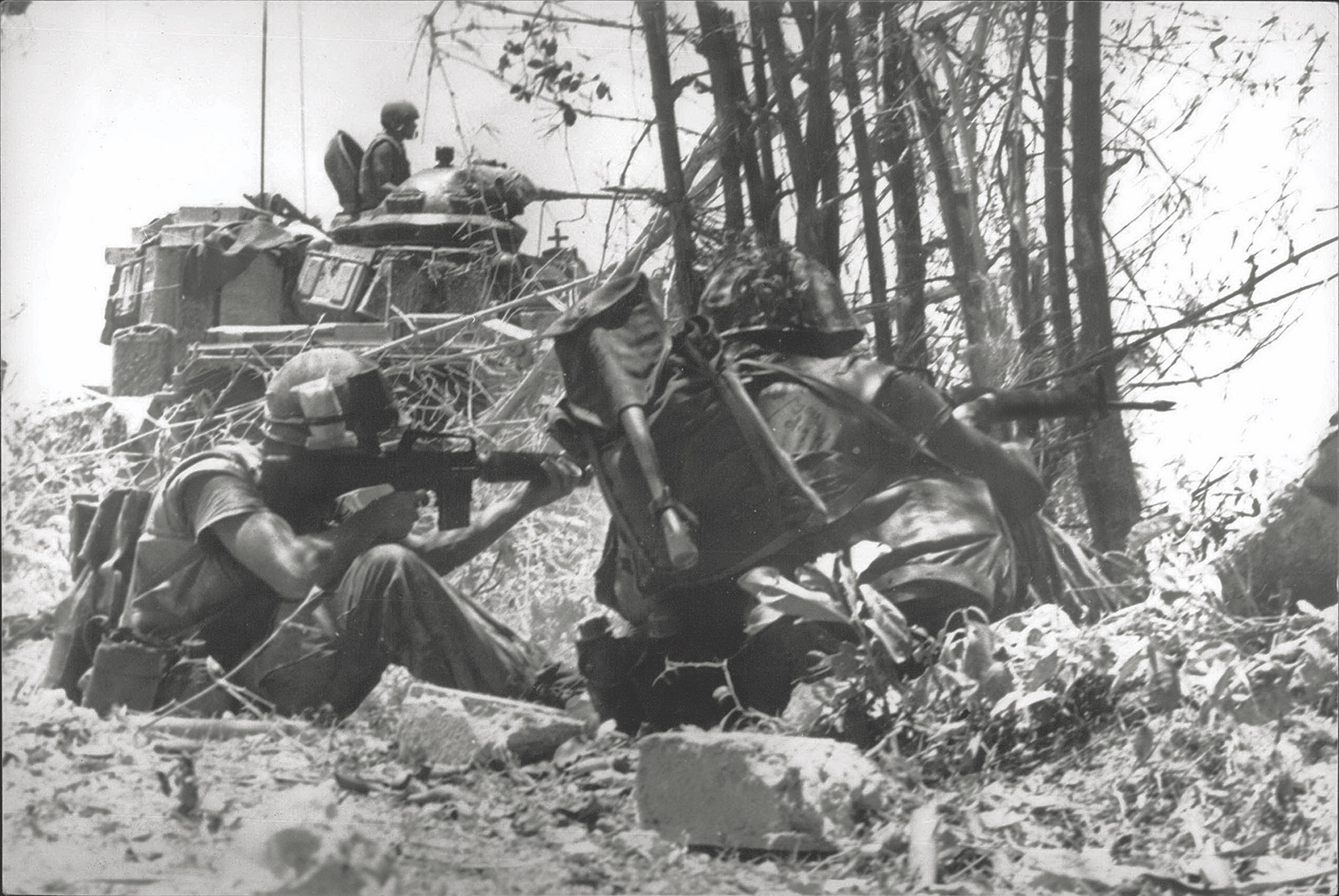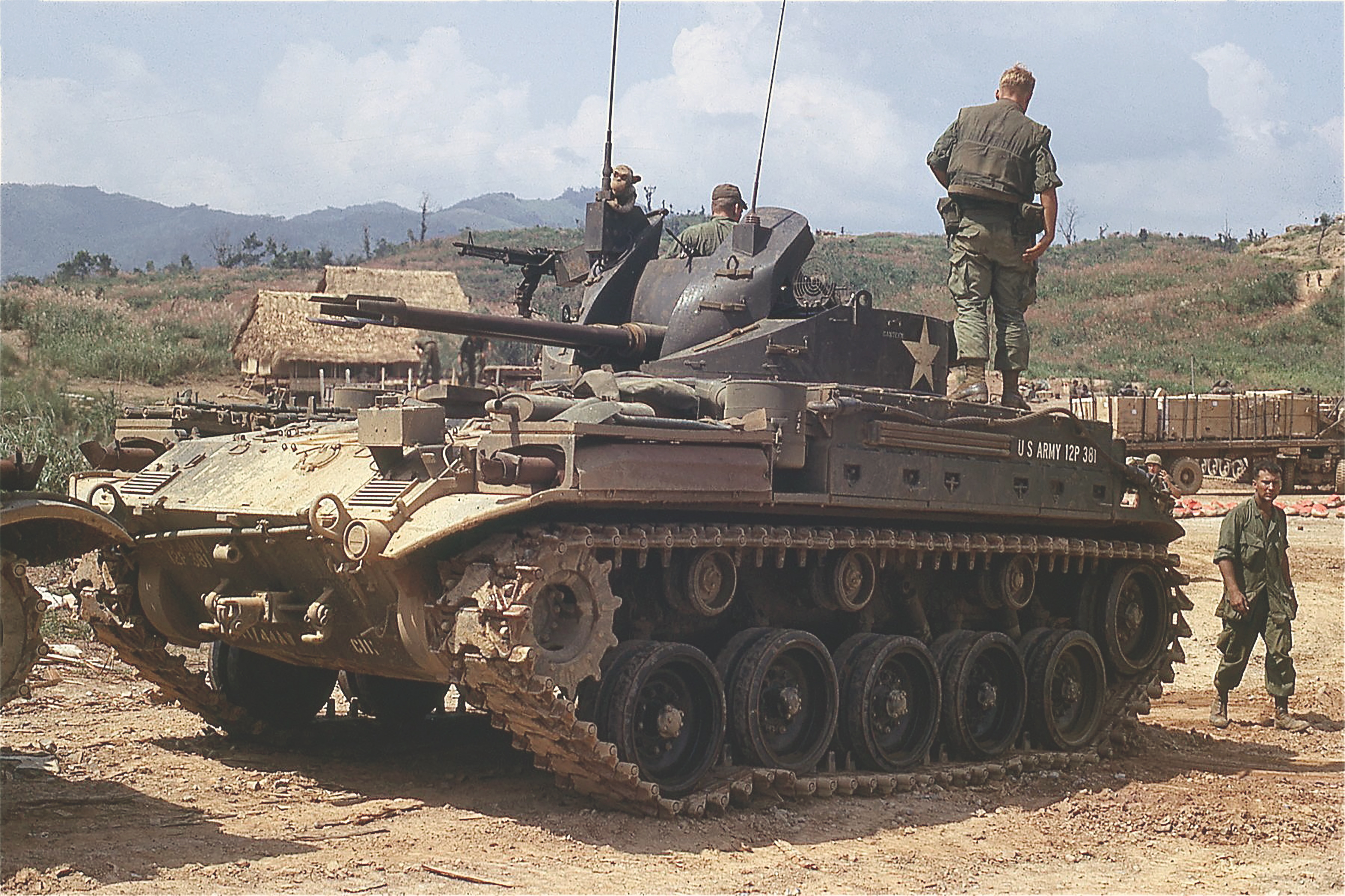The Ambush of Task Force Robbie
In spring 1968, the North Vietnamese Army had set its sights on Dong Ha, a Marine Corps base about 12 miles from the Demilitarized Zone dividing North and South Vietnam. On April 30, the NVA struck near the hamlet of Dai Do, about a mile from Dong Ha, sparking a gunfight that raged through May 3 in one of the war’s deadliest confrontations—which ended in a victory by the outnumbered Marines that became one of the Corps’ legendary battles. But the first American blood in a series of fights that collectively became known as the Battle of Dong Ha was shed about 3 miles to the west on April 29 during a little remembered firefight in the deserted village of Cam Vu.
The NVA planned the attack as a follow-up to the Tet Offensive and the siege of the Marine base at Khe Sanh, near the Laotian border. The communist units that launched the Tet attacks on Jan. 31 had been pushed out of major cities by the end of March, and the Khe Sanh siege, started on Jan. 21, had been broken by U.S. relief forces on April 8. Afterward, the NVA units in northern South Vietnam shifted their focus to the more densely populated eastern coastal plain—specifically Dong Ha.
Nestled on the south side of the Mieu Giang River near the intersection of North-South Highway 1 and East-West Highway 9, Dong Ha was a supply hub for U.S. forces in the region. If the North Vietnamese massed troops across from Dong Ha on the north side of the river, they could disrupt the flow of supplies being ferried to the town from ships offshore and also could cut off shipments heading up Highway 1 to other Marine outposts.
During mid-April, the 320th NVA Division began moving into positions close to Dong Ha. At the time I was stationed near Cam Lo village at Fire Support Base C-3 about 6 miles from Dong Ha. I had been in-country since January and was a U.S. Army first lieutenant assigned as a platoon leader for B Battery, 1st Battalion, 44th Air Defense Artillery Regiment, a unit of M42A1 Dusters (tracked vehicles resembling tanks that were equipped with two 40 mm anti-aircraft guns) and M55 Quad 50 machine guns (four .50-caliber guns mounted in a turret on a 2½-ton cargo truck).
We were attached to the 3rd Marine Division’s Task Force Robbie, established in February by division commander Maj. Gen. Rathvon M. Tompkins as an armored infantry “reaction force” he could send to bolster other units that needed support in a battle.

Firebase C-3 was positioned near the intersection of two main roads, Highway 9 and Route 561, and thus Task Force Robbie—named after its commander, Col. Clifford Robichaud—could be rapidly deployed to any hot spot in the DMZ region.
In addition to getting my Army Dusters and Quad 50s, the task force was stocked with M48A3 Patton tanks, M67A2 flamethrower “Zippo” tanks and M50A1 Ontos vehicles (with a tank body and six 106 mm recoilless rifles) from the Marines’ 3rd Tank Battalion. Additionally, there was a contingent of Marine engineers.
On the afternoon of April 29, Company D, 1st Battalion, 9th Marine Regiment, was temporarily assigned to Task Force Robbie after bitter hill fights near Khe Sanh and airlifted to Cam Lo. James Stone, radio operator for the Company D commander, recalled: “We ended our time at Khe Sanh with an assault on [Hill 471]. We took more than 40 casualties there and were pulled out to Cam Lo for perimeter [defense] and refitting. We thought Cam Lo was the ‘rear area,’ so to speak.” Task Force Robbie now had about 140 men.
The 3rd Marine Division intelligence staff knew in late April that something was afoot in northeastern corner of the DMZ. In a briefing for Task Force Robbie leaders at C-3, we were told that Navy patrol boats had reported unidentified swimmers in the river near Dong Ha on April 24. Four days later, explosives were found attached to pilings on a bridge that crossed the Cam Lo River near C-3. Also, firebases in the eastern DMZ area had been subjected to increased artillery bombardment. And an NVA defector divulged that attacks against South Vietnamese forces in the region were imminent.
Early on April 29, elements of the 320th NVA Division blew up a culvert on Highway 1 just north of the Dong Ha bridge. In response, South Vietnamese commanders sent in two nearby battalions of the 1st Division, Army of the Republic of Vietnam. The ARVN forces had initial success in their battle with the NVA but by midday were in trouble, and their commander radioed Tompkins for assistance. The Marine general ordered Task Force Robbie to support the ARVN battalions.
When Task Force Robbie moved out, operations officer Maj. Bruce MacLaren remained at the C-3 base camp, where he maintained radio contact with task force commander Robichaud on the road and the headquarters staffs for the 3rd Marine Division and 1st Battalion, 9th Marines. MacLaren entered summaries of these radio communications in a log book, the S-3 Journal, the letter-number reflecting the major’s position as a battalion-level staff officer involved in planning and administering combat operations. His notations show how a key member of Task Force Robbie saw the events of April 29 in real time.
MacLaren recorded the order from Tompkins in the S-3 Journal at 3:05 p.m.: Received Beachboy [call sign for Tompkins] order to move to railroad tracks along Rt. 8B.
Tompkins wanted Task Force Robbie to hook up with the embattled ARVN units by taking Route 8B east from Firebase C-3 to the railroad tracks running parallel to Highway 1. Route 8B was an unused dirt road that ran across open flat ground interspersed with dry rice paddies, hedgerows and patches of tall elephant grass. Halfway between C-3 and the ARVN was Cam Vu.
The members of the task force expected the road to be mined, but they had not received any intelligence indicating that NVA troops would stand in their way. “We thought we were going for a walk in the sun,” radio operator Stone remembers.
Robichaud told me to get a Duster and Quad 50 and meet the task force outside the C-3 perimeter. I asked squad leader Sgt. Larry Williams to bring his Duster and Quad 50. At 4 p.m. Task Force Robbie moved along Route 8B in single file. Engineers, sweeping for mines, led the column, followed by Company D infantrymen riding on 10 tanks.
My Duster and Quad 50 had cued up at the rear of the column. The Duster had a crew of six, as I recall, including me in the commander/radio operator compartment next to the driver. Four men were in the Quad 50. The Marines’ Patton tanks also carried four crewmen each, while their flame tanks and Ontos had three.

S-3 Journal, 4:35 p.m.: Tank hit mine at [coordinates]157609. Three routine casualties reported.
About 100 feet in front of me I saw a huge column of dirt blast upward, followed by a loud explosion. The Duster and the Quad 50 quickly pulled ahead to see what happened and found that a Marine flame tank had hit a mine in a dry creek bed. Cpl. John Wear, the gunner in the tank (named “Crispy Critters”) later recalled that “the whole tank bucked up and fell down hard.” There was dust everywhere inside the tank. Wear, tank commander Cpl. Charles West and driver Pfc. Brad Goodwin piled out of the disabled tank, escaping without serious injuries.
S-3 Journal, 5 p.m.: Sit Rep [situation report] to Beachboy— info on mine damage.
As the task force waited for another tank from Firebase C-3 to retrieve the damaged flame tank, Robichaud ordered me to fire on an isolated hooch in an open area about 200 yards to the northeast because the tank explosion might have been remotely detonated by NVA soldiers hidden inside. My Quad 50 reduced the hooch to rubble with a few well-placed bursts of machine gun fire. It took about an hour for another tank to arrive, hook a cable to the disabled tank and tow its crew of three back to camp.
S-3 Journal, 6 p.m.: Sit Rep—continuing the march.
Task Force Robbie had held its position until the disabled flame tank was hauled away.
S-3 Journal, 6:40 p.m.: Engs. blew one mine at xxxxx [location not reported] and resulted in 3 sympathetic explosions.
As we continued on Route 8B, I could hear muffled explosions toward the front of the column as the engineers located and detonated land mines. The Quad 50, the only wheeled vehicle in the column, was more vulnerable to mine damage than the tracked vehicles, and Robichaud ordered me to send it back to C-3.
We passed through Cam Vu around dusk. About 200 yards past the village, the column turned left, heading north on a trunk road in search of another way east to Highway 1 so we could avoid the heavily mined Route 8B. As the column began turning, it received fire. Company D infantrymen dismounted the tanks and counterattacked the enemy. The company’s 3rd Platoon was on the right flank as the infantry began to sweep forward but swung too far to the right (east) and ran into the NVA. A group of 13 Marines in the platoon fought their way through the NVA positions, but the North Vietnamese rapidly closed the gap in their line, cutting the 13 men off from the main American force. Task Force Robbie was receiving heavy small-arms fire, rocket-propelled grenades and incoming 82 mm mortar fire. The task force command group quickly set up in a small cemetery, and I was ordered to cover the rear of the force with my Duster.
“Right at the start of the firefight we lost 3 KIA and many more WIA,” Pfc. Gary Werley, one of the 3rd Platoon Marines in the separated group, recalled in a letter. “We had a tank that we were going to assault with, but they hit it with an RPG…and every time they hit it we had more casualties. The tank pulled out and we started moving our casualties to the rear, then the rest of the platoon pulled out.” He added, “They pinned us down with chicoms [long wooden-handled grenades that were variants of grenades made by Chinese communists] and AK-47 fire.” The fighting was fierce and, in some cases, face-to-face.
S-3 Journal, 6:55 p.m.: Received info from 1/9 COC [1st Battalion, 9th Marines, command operations center] relative to 2 VC companies located at 173610 and 184603. Info passed to CO TFR [Robichaud, commanding officer, Task Force Robbie].
Marine intelligence put the enemy’s strength in the area at two companies. The NVA apparently was trying to prevent Task Force Robbie from reinforcing the ARVN on Highway 1. The NVA were dug in, had 82 mm mortar support and an ample supply of RPGs.
S-3 Journal, 7:50 p.m.: CO TFR Advised Beachboy that TF had run into a little more than it could handle. Will retrograde to C-3.
After an hour into the firefight it was obvious that Task Force Robbie’s troops could not fight their way through the enemy blocking force. The Marines were engaged with the NVA at close quarters, and casualties continued to mount. All four Ontos were damaged by mortar fire, with one crewman being wounded. Three of the 10 tanks had suffered mine and RPG damage.
It was now dark, and Task Force Robbie was in an untenable position. Its infantry consisted of one depleted Marine rifle company—with 13 men cut off behind enemy lines. The opponents were fresh, well-armed NVA soldiers.
S-3 Journal, 8 p.m.: Sit Rep—still trying to extract.
To stabilize the situation for a withdrawal, Robichaud called for artillery fire to weaken the enemy units. Forward air controller Cpl. John Brooks, who normally coordinated airstrikes, worked with the artillery support that night. At one point he crawled on top of a burial mound in the cemetery to direct 105 mm howitzer fire from nearby Marine combat bases.
He also called in an Air Force C-123 Provider “Candlestick” plane to drop flares that parachuted to the ground and illuminated the battlefield.
Meanwhile, the infantry began to disengage. First, tanks were lined up abreast, about 20 yards apart, facing the enemy. Then, with the night sky lit by the C-123 flares, Company D moved back, passing through the protective line of tanks. But there remained the problem of the cutoff riflemen of 3rd Platoon.

S-3 Journal, 9 p.m.: Rep—Still attempting to withdraw. C-6 [call sign for a company commander with the task force, possibly tank Company C or infantry Company D] staying behind to assist infantry withdrawal. One unit is pinned down.
The 3rd Platoon’s 13 men who were trapped behind enemy lines formed themselves into a 360-degree defensive position while waiting for help from the main unit. They maintained radio silence because the transmission could reveal their location to the NVA. Their fellow Marines on the tank line used a high-intensity searchlight mounted on one of the tanks to hunt for them. The light swept slowly along the ground in an arc until the beam was directly over the cutoff Marines. While the beam was fixed on that spot, two other tanks raced out to the trapped Marines. “The seven walking Marines, five WIAs, and one KIA were all loaded post haste on the tanks which quickly returned to friendly lines,” Werley wrote in his letter.
S-3 Journal, 9:30 p.m.: Red Alert set by COC 1/9 based on [enemy] troop movements to our north. VIC coordinates 162637.
My Duster—still in the rear of our position, where it had been ordered at the beginning of the fight to cover the back of the task force—was in a clearing partially enclosed by a large thicket of elephant grass. A tank sent from Firebase C-3 to assist with the withdrawal had arrived and stopped about 20 yards to my right, but as soon as it pulled up an RPG arced out from the elephant grass thicket and hit the turret, sending up a shower of white sparks.
By the light of the aerial flares I watched with some trepidation as a wounded tanker was lifted out. Would my Duster be the next target? There was no movement in the elephant grass—just an eerie silence, and as descending flares swung in their parachutes, every shadow rocked back and forth in unison, all around us.
Suddenly I received an urgent radio message from Robichaud, telling me that headquarters of the 1st Battalion, 9th Marines, had issued a Red Alert, indicating an imminent attack. A C-123 crew dropping flares had spotted an NVA force marching rapidly down from the north toward Task Force Robbie.
I guessed the NVA reinforcements would avoid the open ground to our rear and attack through the thicket of elephant grass. I didn’t see any enemy approaching, so I decided the best defense was a Duster “recon by fire,” spraying the entire area of suspected enemy presence with 40 mm fire. The Duster crew began raking the gunfire back and forth on the thicket. Bright explosions lit up the night and a wall of flying shell fragments ripped up the edge of the brush. If any NVA troops attempted to infiltrate through the elephant grass, they never made it.
S-3 Journal, 10:35 p.m.: TF leaving perimeter at stream and attempting to return. Alerted 1/9 that we might need their assistance.
Shortly after the Duster fire mission, Task Force Robbie got back on Route 8B for a return to Firebase C-3. My Duster was at the rear of column. Supporting artillery from the nearby bases to the north put up an enormous protective barrage until we were out of danger.
S-3 Journal, 11:15 p.m. Rec’d word TFR clear of area. Notified BB 3X to shoot Cam Vu area. [BB 3X was probably the 3rd Marine Division S-3 officer.]
After a few hundred feet my Duster came upon a Marine rifleman who was limping from a bloody wound in his thigh and had fallen behind the others on the march. We helped him get aboard behind the turret for the ride back.
S-3 Journal, 11:27 p.m.: CO TFR back to C-3.
The Marines’ casualty tally was four killed, 29 wounded and six missing. The following day the bodies of the six missing Marines were found on the battlefield, and several days later another Marine died from his wounds, bringing the total to 11 killed and 28 wounded. Company D reported 22 enemy killed.
After the NVA ambush halted Task Force Robbie’s march to the embattled South Vietnamese units, the two ARVN battalions broke contact with the NVA and retreated.
S-3 Journal, 12 midnight: Closing Entry: Summary of events. TF had heavy engagement west of Cam Vu. Area infested w/NVA, well-armed w/mines and RPGs.
The day after Task Force Robbie’s encounter with the NVA at Cam Vu, Tompkins ordered the 3rd Battalion, 9th Marines, airlifted into C-3 to replace the 1st Battalion’s Company D. On April 30, the 3rd Battalion attacked the NVA near Cam Vu with tanks and three full companies, rather than the single company that had fought there the night before. In several battles over the next few days, the 3rd Battalion drove the NVA from the field. The battalion’s casualties from April 30 to May 3 totaled 42 killed and more than 70 wounded.
Those were gut-wrenching losses, but the Battle for Dong Ha saw larger and bloodier battles, particularly in the area near Dai Do (87 killed, nearly 300 wounded), before the fighting was largely over in mid-May as the 320th NVA Division fell back into North Vietnam. The Dong Ha engagements overall cost U.S. forces 327 killed and more than 1,500 wounded. NVA losses were estimated at 3,600 dead.
Richard H. Smiley, Ph.D., was an Army platoon leader in B Battery, 1st Battalion, 44th Air Defense Artillery Regiment, near the DMZ and later team leader of Mobile Advisory Team 65 in the Mekong Delta in 1968. He is a retired psychologist living in Pahrump, Nevada. He thanks John Wear for his assistance.

